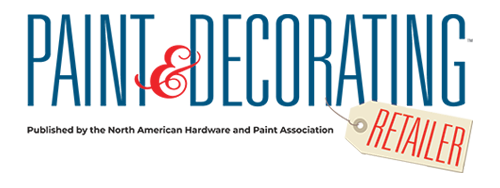
Zach Maddux (left) co-owns Columbia Paint & Wallcovering in Columbia, Tennessee, with his father, Zeke Maddux.
When it comes to paint applicators, there are countless options available for retailers to stock and customers to shop. While applicators, sponges and rags are often overlooked by retailers, investing time and money in these products can result in increased sales and higher customer satisfaction and loyalty.
Ralph Maddux opened Columbia Paint & Wallcovering in Columbia, Tennessee, in 1946. In 2009, Ralph’s grandson Zach Maddux returned to his family’s business and is now a third-generation co-owner of the operation with his father, Zeke Maddux. The 6,000-square-foot store serves an equal mix of contractors and DIYers in a flourishing town about 60 miles south of Nashville, Tennessee. With over 80 feet of selling space dedicated to applicators, sponges and rags in his store, Zach Maddux shares five best practices to boost sales in this category.
Seeking Knowledge: Give your customers paint applicator know-how. Learn more at PDRmag.com/educating-applicators.
1. Target Cabinet Shops to Increase Rag Sales.
The applicators, sponges and rags category presents numerous opportunities for cross-merchandising, which leads to add-on sales.
Maddux increased the number of stain and lacquer products the store carries, bringing in more business from cabinet shops and furniture manufacturers, which grew lacquer sales and in turn, rag sales.
“Cabinet refinishing and painting has also become trendy with DIYers in the last few years, boosting rag and applicator sales even more,” Maddux says. “We make sure to stock the products needed for those projects and steer DIYers in the right direction when we can.”

2. Find New Products Through Contractors, Vendor Reps and Other Friends In the Industry.
Columbia Paint & Wallcovering’s building used to be a grocery store, so it is larger than the average paint store and can merchandise a wider variety of products. Thanks to this selection, it has become a destination for applicators for some customers, Maddux says.
“Any time a painter comes in and asks for a specific brush we don’t have, we add it to our mix,” Maddux says. “We have painters come from out of town to browse this category because it is so extensive and offers the largest selection for miles.”
Using contacts in the industry can also keep you up to date on the newest product trends.
“Our vendor representatives always recommend new products and let us know how similar retailers are doing with specific products,” Maddux says. “Having good relationships with vendors can lead to free samples of products you can give to painters to increase loyalty. We’re also friends with other paint store owners throughout the country and get recommendations from them.”

Sell the Whole Project: Share these tips for completing exterior wood projects to establish yourself as a project expert at PDRmag.com/exterior-wood.
3. Counter Displays Can Make a Difference.
Maddux says he was against counter displays at first because he thought they made the area cluttered.
“I have a vendor that recently sent me a counter display for one-pound bags of rags,” Maddux says. “I decided to give it a shot and put the display box on the counter. It’s done surprisingly well, and now we’re constantly restocking it.”

4. Ask Questions for More Sales and Increased Customer Loyalty.
Asking customers questions about what project they are trying to complete often leads to add-on sales or an upsell to a more quality product option.
“Asking questions allows employees to lead the customer to the product that will best complete their project, not necessarily just the product the customer requested or thought they wanted,” Maddux says. “Questions show customers your interest, build trust and deepen your relationship with your customer.”

Pro Insights: Discover insights on the differences between selling sponges and rags to contractors and to DIYers at PDRmag.com/sponge-options.
5. Merchandise with Intent.
Keeping your applicators, sponges and rags organized will make it easier for customers to find what they need and lead to a more satisfying shopping experience.
“We organize our applicators, sponges and rags by brand and project,” Maddux says. “We also stock for every budget.”
While keeping categories organized is a good start, switching up product locations can also lead to increased sales.
“We try to move applicators, sponges and rags around constantly to make customers walk by new products and hopefully add to their purchase,” Maddux says. “We also move products around when seasons change. For example, in the spring we pull out more deck staining applicators and place them front and center for deck staining season.”
Merchandising differently for DIYers and contractors can also make for an easier shopping experience and boosted sales.
“We recently started stocking a product line that is meant for DIYers, so we added a section away from the other applicators with these products and created signage to draw DIYers’ attention,” Maddux says.








